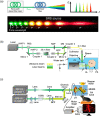Sounding out the dynamics: a concise review of high-speed photoacoustic microscopy
- PMID: 38323297
- PMCID: PMC10846286
- DOI: 10.1117/1.JBO.29.S1.S11521
Sounding out the dynamics: a concise review of high-speed photoacoustic microscopy
Abstract
Significance: Photoacoustic microscopy (PAM) offers advantages in high-resolution and high-contrast imaging of biomedical chromophores. The speed of imaging is critical for leveraging these benefits in both preclinical and clinical settings. Ongoing technological innovations have substantially boosted PAM's imaging speed, enabling real-time monitoring of dynamic biological processes.
Aim: This concise review synthesizes historical context and current advancements in high-speed PAM, with an emphasis on developments enabled by ultrafast lasers, scanning mechanisms, and advanced imaging processing methods.
Approach: We examine cutting-edge innovations across multiple facets of PAM, including light sources, scanning and detection systems, and computational techniques and explore their representative applications in biomedical research.
Results: This work delineates the challenges that persist in achieving optimal high-speed PAM performance and forecasts its prospective impact on biomedical imaging.
Conclusions: Recognizing the current limitations, breaking through the drawbacks, and adopting the optimal combination of each technology will lead to the realization of ultimate high-speed PAM for both fundamental research and clinical translation.
Keywords: computational techniques; deep-learning; high-speed light source; high-speed scanning; optical acoustic detection; optoacoustic microscopy; photoacoustic microscopy.
© 2024 The Authors.
Figures






References
Publication types
MeSH terms
Grants and funding
LinkOut - more resources
Full Text Sources
Miscellaneous

